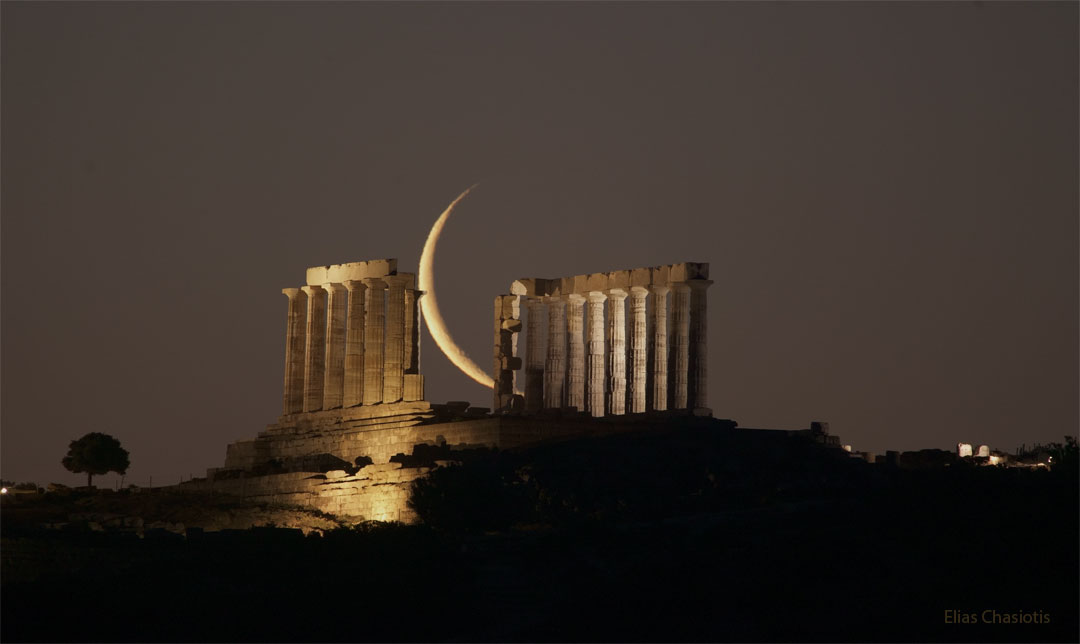28. February 2023
希臘廟寺 kah 遠方 ê 月眉

探索宇宙1!逐工會揀一幅無仝款 ê 影像抑是相片,𤆬你熟似咱這个迷人 ê 宇宙,閣有專業天文學者2為你3解說4。
- 原始文章:Crescent Moon Beyond Greek Temple
- 影像來源 kah 版權:Elias Chasiotis
- 台文翻譯:An-Li Tsai (NCU)
[漢羅] 希臘廟寺 kah 遠方 ê 月眉
是按怎咱看著 ê 薄月眉,干焦會出現 tī 地平線附近? 因為 幾何 上,會出現這款薄月眉 ê 月相,是愛 月娘 tī 太空中行到倚 日頭 ê 方向才有可能。 月眉這个月相,毋是因為伊去予 地球烏影 閘著矣。 咱看著遮爾少 ê 部份,是因為干焦這面去予日光照著。 而且,月眉 上厚 ê 部份總是出現 tī 日頭 ê 方向。 暗頭仔彼陣,薄月眉 會 tī 日頭落山了後隨綴伊落去,紲落來規暝攏看袂著伊。 雖罔講規暝攏無看著月娘,毋過 tī 透早時,月眉會 tī 日頭 peh--起來進前先 peh--起來。 這張相片是兩禮拜前,tī 日出進前,月眉出現 tī 地平線附近 翕著--ê。 月娘就 tī 希臘 古老 ê Poseidon 廟寺 遺蹟 ê 遠方。
[POJ] Hi-la̍h biō-sī kah Oán-hong ê Goe̍h-bâi
Sī án-ná lán khòaⁿ--tio̍h ê po̍h goe̍h-bâi, kan-na ē chhut-hiān tī tē-pêng-sòaⁿ hù-kīn? In-ūi kí-hô siòng, ē chhut-hiān chit-khoán po̍h goe̍h-bâi ê goe̍h-siòng, sī ài goe̍h-niû tī thài-khong tiong kiâⁿ kàu óa ji̍t-thâu ê hong-hiòng chiah ū khó-lêng. Goe̍h-bâi chit ê goe̍h-siòng, m̄-sī in-ūi i khì hō͘ Tē-kiû o͘-iáⁿ cha̍h tio̍h--ah. Lán khòaⁿ-tio̍h chiah-nī chió ê pō͘-hūn, sī in-ūi kan-na chit bīn khì hō͘ ji̍t-kng chiò--tio̍h. Jî-chhiáⁿ, goe̍h-bâi siōng kāu ê pō͘-hūn chóng-sī chhut-hiān tī ji̍t-thâu ê hong-hiòng. Àm-thâu-á hit-chūn, po̍h goe̍h-bâi ē tī ji̍t-thâu lo̍h-soaⁿ liáu-āu sûi tòe i lo̍h-khì, sòa-lo̍h-lâi kui-mî lóng khòaⁿ bē-tio̍h i. Sui-bóng kóng kui-mî lóng bô khòaⁿ-tio̍h goe̍h-niû, m̄-koh tī thàu-chá sî, goe̍h-bâi ē tī ji̍t-thâu peh--khí-lâi chìn-chêng seng peh--khí-lâi. Chit tiuⁿ siòng-phìⁿ sī nn̄g lé-pài chêng, tī ji̍t-chhut chìn-chêng, goe̍h-bâi chhut-hiān tī tē-pêng-sòaⁿ hù-kīn hip--tio̍h--ê. Goe̍h-niû to̍h tī Hi-la̍h kó͘-nó͘ ê Poseidon biō-sī ûi-chek ê oán-hong.
[KIP] Hi-la̍h biō-sī kah Uán-hong ê Gue̍h-bâi
Sī án-ná lán khuànn--tio̍h ê po̍h gue̍h-bâi, kan-na ē tshut-hiān tī tē-pîng-suànn hù-kīn? In-uī kí-hô siòng, ē tshut-hiān tsit-khuán po̍h gue̍h-bâi ê gue̍h-siòng, sī ài gue̍h-niû tī thài-khong tiong kiânn kàu uá ji̍t-thâu ê hong-hiòng tsiah ū khó-lîng. Gue̍h-bâi tsit ê gue̍h-siòng, m̄-sī in-uī i khì hōo Tē-kiû oo-iánn tsa̍h tio̍h--ah. Lán khuànn-tio̍h tsiah-nī tsió ê pōo-hūn, sī in-uī kan-na tsit bīn khì hōo ji̍t-kng tsiò--tio̍h. Jî-tshiánn, gue̍h-bâi siōng kāu ê pōo-hūn tsóng-sī tshut-hiān tī ji̍t-thâu ê hong-hiòng. Àm-thâu-á hit-tsūn, po̍h gue̍h-bâi ē tī ji̍t-thâu lo̍h-suann liáu-āu suî tuè i lo̍h-khì, suà-lo̍h-lâi kui-mî lóng khuànn bē-tio̍h i. Sui-bóng kóng kui-mî lóng bô khuànn-tio̍h gue̍h-niû, m̄-koh tī thàu-tsá sî, gue̍h-bâi ē tī ji̍t-thâu peh--khí-lâi tsìn-tsîng sing peh--khí-lâi. Tsit tiunn siòng-phìnn sī nn̄g lé-pài tsîng, tī ji̍t-tshut tsìn-tsîng, gue̍h-bâi tshut-hiān tī tē-pîng-suànn hù-kīn hip--tio̍h--ê. Gue̍h-niû to̍h tī Hi-la̍h kóo-nóo ê Poseidon biō-sī uî-tsik ê uán-hong.
[English] Crescent Moon Beyond Greek Temple
Why is a thin crescent moon never seen far from a horizon? Because the only geometry that gives a thin crescent lunar phase occurs when the Moon appears close to the Sun in the sky. The crescent is not caused by the shadow of the Earth, but by seeing only a small part of the Moon directly illuminated by the Sun. Moreover, the thickest part of the crescent always occurs in the direction of the Sun. In the evening, a thin crescent Moon will set shortly after the Sun and not be seen for the rest of the night. Alternatively, in the morning, a crescent Moon will rise shortly before the Sun after not being seen for most of the night. Pictured two weeks ago, a crescent moon was captured near the horizon, just before sunrise, far behind remnants of the ancient Temple of Poseidon in Greece.
詞彙學習
| 漢羅 | POJ | KIP | 華語 | English |
|---|---|---|---|---|
| 月眉 | goe̍h-bâi | gue̍h-bâi | 新月 | crescent |
| 地平線 | tē-pêng-sòaⁿ | tē-pîng-suànn | 地平線 | horizon |
| 月相 | goe̍h-siòng | gue̍h-siòng | 月相 | lunar phase |
| 幾何 | kí-hô | kí-hô | 幾何 | geometry |
| 遺蹟 | ûi-chek | uî-tsik | 遺蹟 | remnants |